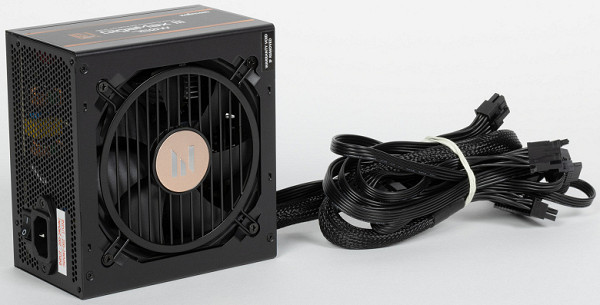
We received a relatively affordable power supply under the Zalman brand for testing — Gigamax III 750W (ZM750-GV3). This power supply has a power of 750 W. The series also includes models with a power of 650 and 850 W, but there are no models with the most popular powers of 500-550 W in stock. All models in this series are 80Plus Bronze certified and feature a new power connector for PCIe 5.0 graphics cards (12VHPWR).
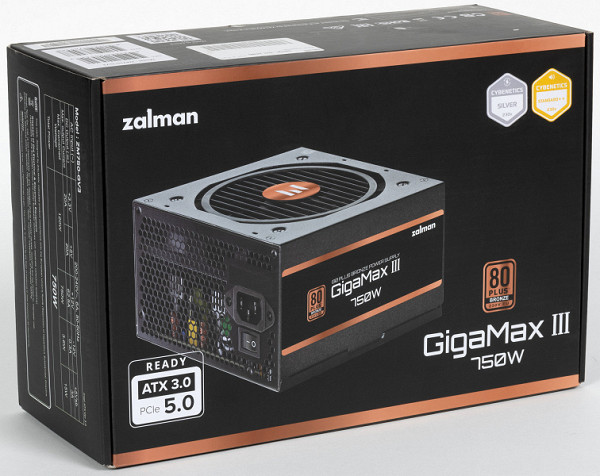
The power supply packaging is made of durable cardboard with a matte finish and an illustration of the power supply itself. Shades of black and brown predominate.
Characteristics
All main parameters are indicated on the power supply housing in full. The power on the +12VDC bus is 750 W, which corresponds to 100% of the total power, which is an excellent indicator.
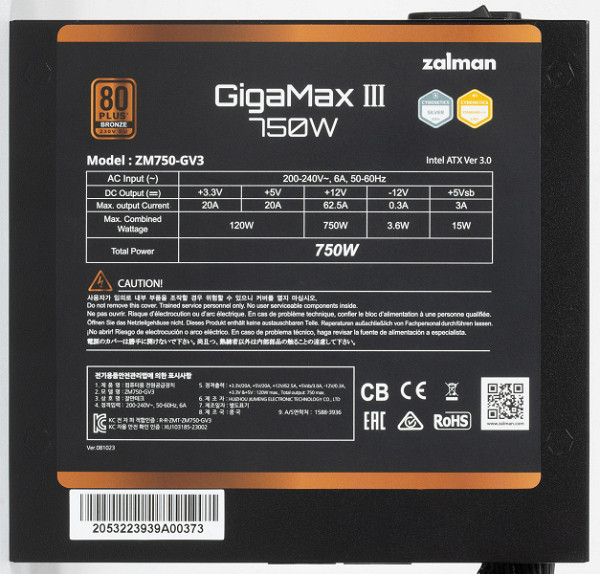
Wires and connectors

| Name of the connector | Number of connectors | Notes |
|---|---|---|
| 24 pin Main Power Connector | 1 | collapsible |
| 4 pin 12V Power Connector | — | |
| 8 pin SSI Processor Connector | 2 | on one cord, one detachable |
| 6 pin PCIe 1.0 VGA Power Connector | — | |
| 8 pin PCIe 2.0 VGA Power Connector | 4 | on 2 cords |
| 16 pin PCIe 5.0 VGA Power Connector | 1 | |
| 4 pin Peripheral Connector | 3 | |
| 15 pin Serial ATA Connector | 6 | on 2 cords |
| 4 pin floppy drive connector | — |
Length of wires to power connectors
- 1 cord: to the main ATX connector — 55 cm
- 1 cord: to the 8 pin SSI processor socket — 70 cm, plus another 15 cm to the second similar connector
- 2 cords: to the first PCIe 2.0 VGA Power Connector video card power connector — 55 cm, plus another 15 cm to the second same connector
- 1 cord: to the video card power connector PCIe 5.0 VGA Power Connector — 60 cm
- 2 cords: to the first SATA Power Connector — 45 cm, plus 15 cm to the second and another 15 cm to the third similar connector
- 1 cord: to the first Peripheral Connector (Molex) — 45 cm, plus 15 cm to the second and another 15 cm to the third similar connector
Almost all power cables in this unit are fixed, with the exception of those that go to the video cards. This decision may cause confusion, given that users often use at least one video card when choosing a powerful power supply. At the same time, the plethora of SATA connectors and legacy peripheral standards are not commonly used in modern systems, and the absence of modular wiring could improve ventilation in the case. However, the chosen option is not a disadvantage, but simply less convenient compared to power supplies with fully modular wires.
The length of the wires is designed for installation of the power supply in large and tall Full tower cases or on open stands. For example, the cable to the extreme processor socket reaches about 83 cm.
SATA Power connectors are mostly angled, which can be inconvenient when using drives located on the back of the motherboard base. However, in typical multi-drive systems this is rarely a problem.
A positive feature is the use of ribbon wires, which are easy to use as they do not accumulate dust. However, the motherboard power connector still uses a regular nylon braided cord.
Circuit design and cooling
The power supply is equipped with an active power factor correction, but does not have a very wide range of supply voltages from 200 to 240 volts.

The main semiconductor components are mounted on two compact heatsinks with small fins. The +3.3VDC and +5VDC sources are located on the daughter printed circuit board and, as a rule, do not have additional heat sinks — this is typical for power supplies with active cooling.
The high-voltage circuits have semiconductor elements located on a single heatsink, although the input rectifier does not have a heatsink. The rectifier elements are installed on a separate radiator.
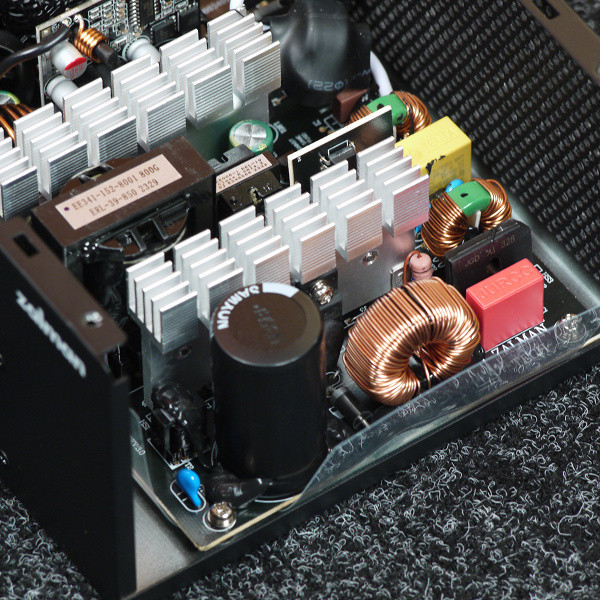
The device contains capacitors manufactured under the Samxon (high-voltage) and ChengX brands.
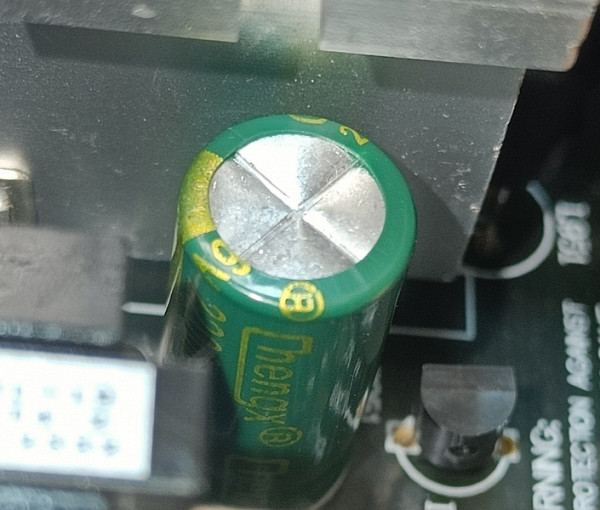

A number of polymer capacitors are also installed here.
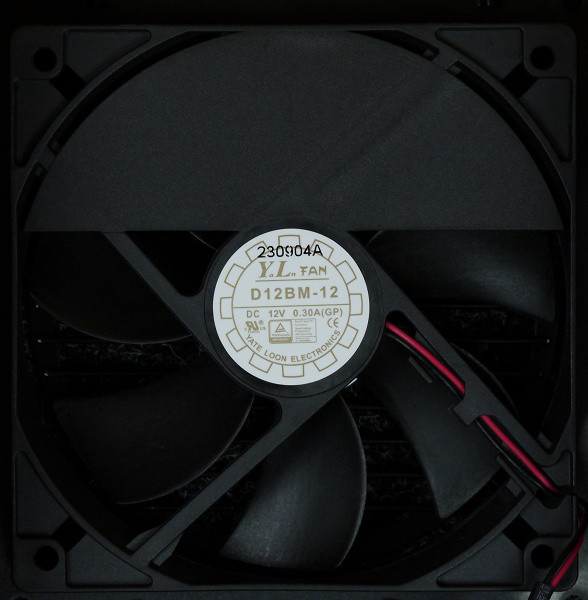
Under the grille is a 120mm D12BM-12 fan manufactured by Yate Loon Electronics. Zalman claims that this power supply uses a fluid dynamic bearing (FDB), but on the Yate Loon website, the model with this marking refers to fans based on rolling element bearings. Either way, it's a quality choice. The service life of such fans usually significantly exceeds the warranty period for the power supply itself.
The fan is connected with a standard two-wire connector, which makes it easy to replace it if necessary.
Electrical Characteristics Measurement
Next, we move on to studying the electrical characteristics of the power source using a multifunctional stand and other equipment.
Deviations of output voltages from the nominal are color coded as follows:
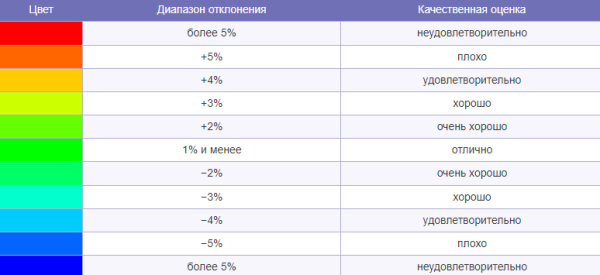
Operating at maximum power
The first stage of testing is to use the power supply at maximum power for an extended period of time. Such a test allows you to confidently verify the functionality of the power supply.
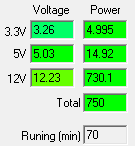
Cross-load characteristic
The next stage of instrumental testing is the construction of a cross-load characteristic (CLC) and its display on a quarter-plane, where one ordinate axis is limited by the maximum bus power of 3.3 & 5 V, and the other abscissa axis is limited by the maximum bus power of 12 V. At each point, the measured voltage value is indicated color marker depending on the deviation from the nominal value.

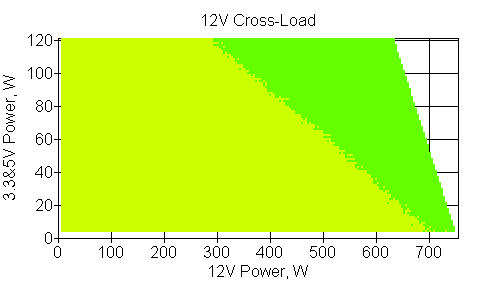
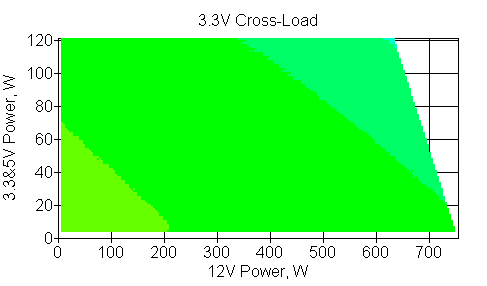
The cross-load characteristic (CLC) allows you to determine the permissible load level for the power supply being tested, especially on the +12VDC channel. In this case, voltage deviations from the nominal value on the +12VDC channel do not exceed 3% over the entire power range, which is a good result. It is noted that the deflection increases at low loads, but at high loads this does not pose a problem.
With a typical power distribution across channels, deviations from the nominal are up to 2% for the +3.3VDC channel, up to 3% for the +5VDC channel and up to 3% for the +12VDC channel.
This power supply model is well suited for modern powerful systems due to the high load capacity of the +12VDC channel.
Load capacity
The following test is aimed at determining the maximum power that can be supplied through the corresponding connectors when the voltage deviation is 3 or 5 percent from the nominal.

In the case of a video card with a single power connector, the maximum power over the +12VDC channel is at least 150 W with a deviation within 3%.

In the case of a video card with two power connectors when using one power cord, the maximum power over the +12VDC channel is at least 250 W with a deviation within 3%.

When using two power cords for a video card with two connectors, the maximum power over the +12VDC channel is at least 350 W with a deviation within 3%, which makes it possible to use very powerful video cards.

When using two power cords for a video card with two connectors, the maximum power over the +12VDC channel is at least 350 W with a deviation within 3%, which makes it possible to use very powerful video cards.

When loaded through the processor power connector, the maximum power through the +12VDC channel is at least 250 W with a deviation within 3%. This is quite enough for typical systems, where the motherboard has only one connector for powering the processor.

When loaded through two processor power connectors, the maximum power via the +12VDC channel is at least 500 W with a deviation within 3%.

In the case of a motherboard, the maximum power on the +12VDC channel is at least 150 W with a deviation within 3%. This provides enough power to power all motherboard components, including possible expansion cards, such as graphics cards without an additional power connector, which typically consume up to 75 W.
Cost-effective and efficient
When assessing the efficiency of a computer power supply, two approaches can be distinguished. The first is to consider it as an electrical energy converter in order to minimize losses when transferring energy from the power supply to the load. To do this, the power supply is connected with all available connectors, which does not always correspond to real operating conditions, where a limited number of connectors are used. The second approach is associated with assessing efficiency based on power consumption and dissipation, which makes it possible to assess the actual energy efficiency of the power supply when operating with a constant load.
The efficiency of a computer power supply is traditionally measured through the coefficient of performance (COP), which reflects the ratio of output and input power. Although high efficiency indicates the efficiency and quality of the power supply, for the average user this parameter is not always decisive, since it does not directly affect the performance or performance of the system.
When assessing the efficiency of a power supply, it is important to take into account power dissipation — the difference between input and output powers. This value can be converted into kilowatt-hours, which allows you to evaluate the economic benefits of using different power supply models over long-term operation. The actual cost of running a computer with different power supplies can vary significantly depending on their energy efficiency and the price of electricity.
Thus, the approach to estimating power dissipation allows us to get a more specific idea of the efficiency and cost of operating a power supply unit in real conditions of using a computer.
| Load via connectors | 12VDC, W | 5VDC, W | 3.3VDC, W | Total power, W |
|---|---|---|---|---|
| Main ATX, CPU (12V), SATA | 5 | 5 | 5 | 15 |
| Main ATX, CPU (12V), SATA | 80 | 15 | 5 | 100 |
| Main ATX, CPU (12V), SATA | 180 | 15 | 5 | 200 |
| Main ATX, CPU (12V), 6-pin PCIe, SATA | 380 | 15 | 5 | 400 |
| Main ATX, CPU (12V), 6-pin PCIe (1 cable with 2 connectors), SATA | 480 | 15 | 5 | 500 |
| Main ATX, CPU (12V), 6-pin PCIe (2 cables with 1 connector), SATA | 480 | 15 | 5 | 500 |
| Main ATX, CPU (12V), 6-pin PCIe (2 cables with 2 connectors), SATA | 730 | 15 | 5 | 750 |
The results obtained are as follows:

| Dissipated power, W | 15 W | 100 W | 200 W | 400 W | 500 W (1 cord) | 500W (2 cords) | 750 W |
|---|---|---|---|---|---|---|---|
| Cougar BXM 700 | 12.0 | 18.2 | 26.0 | 42.8 | 57.4 | 57.1 | |
| Cooler Master Elite 600 V4 | 11.4 | 17.8 | 30.1 | 65.7 | 93.0 | ||
| Cougar GEX 850 | 11.8 | 14.5 | 20.6 | 32.6 | 41.0 | 40.5 | 72.5 |
| Cooler Master V650 SFX | 7.8 | 13.8 | 19.6 | 33.0 | 42.4 | 41.4 | |
| Chieftec BDF-650C | 13.0 | 19.0 | 27.6 | 35.5 | 69.8 | 67.3 | |
| XPG Core Reactor 750 | 8.0 | 14.3 | 18.5 | 30.7 | 41.8 | 40.4 | 72.5 |
| Deepcool DQ650-M-V2L | 11.0 | 13.8 | 19.5 | 34.7 | 44.0 | ||
| Deepcool DA600-M | 13.6 | 19.8 | 30.0 | 61.3 | 86.0 | ||
| Fractal Design Ion Gold 850 | 14.9 | 17.5 | 21.5 | 37.2 | 47.4 | 45.2 | 80.2 |
| XPG Pylon 750 | 11.1 | 15.4 | 21.7 | 41.0 | 57.0 | 56.7 | 111,0 |
| Chieftronic PowerUp GPX-850FC | 12.8 | 15.9 | 21.4 | 33.2 | 39.4 | 38.2 | 69.3 |
| MSI MPG A750GF | 11.5 | 15.7 | 21.0 | 30.6 | 39.2 | 38.0 | 69.0 |
| Chieftronic PowerPlay GPU-850FC | 12.0 | 15.9 | 19.7 | 28.1 | 34.0 | 33.3 | 56.0 |
| Cooler Master MWE Gold 750 V2 | 12.2 | 16.0 | 21.0 | 34.6 | 42.0 | 41.6 | 76.4 |
| XPG Pylon 450 | 12.6 | 18.5 | 28.4 | 63.0 | |||
| Chieftronic PowerUp GPX-550FC | 12.2 | 15.4 | 21.6 | 35.7 | 47.1 | ||
| Chieftec BBS-500S | 13.3 | 16.3 | 22.2 | 38.6 | |||
| Cougar VTE X2 600 | 13.3 | 18.3 | 28.0 | 49.3 | 64.2 | ||
| Thermaltake GX1 500 | 12.8 | 14.1 | 19.5 | 34.8 | 47.6 | ||
| Thermaltake BM2 450 | 12.2 | 16.7 | 26.3 | 57.9 | |||
| Super Flower SF-750P14XE | 14.0 | 16.5 | 23.0 | 35.0 | 42.0 | 44.0 | 76.0 |
| XPG Core Reactor 850 | 9.8 | 14.9 | 18.1 | 29.0 | 38.4 | 37.0 | 63.0 |
| Asus TUF Gaming 750B | 11.1 | 13.8 | 20.7 | 38.6 | 50.7 | 49.3 | 93.0 |
| Chieftronic BDK-650FC | 12.6 | 14.3 | 20.4 | 41.1 | 53.5 | 50.6 | |
| Cooler Master XG Plus 750 Platinum | 13.8 | 14.2 | 18.9 | 36.5 | 43.0 | 40.0 | 61.1 |
| Chieftec GPC-700S | 15.6 | 21.4 | 30.9 | 63.5 | 84.0 | ||
| Zalman ZM700-TXIIv2 | 12.5 | 19.5 | 30.8 | 62.0 | 83.0 | 80.0 | |
| Cooler Master V850 Platinum | 17.8 | 20.1 | 24.6 | 34.5 | 38.3 | 37.8 | 58.5 |
| Chieftec CSN-650C | 10.7 | 12.5 | 17.5 | 32.0 | 43.5 | ||
| Powerman PM-300TFX | 12.0 | 20.0 | 38.2 | ||||
| Chieftec GPA-700S | 13.4 | 19.3 | 30.3 | 64.1 | 86.5 | ||
| XPG Probe 600W | 12.8 | 19.6 | 29.5 | 58.0 | 80.0 | ||
| Super Flower Leadex VII XG 850W | 11.7 | 14.5 | 18.4 | 26.7 | 32.2 | ||
| Cooler Master V850 Gold i Multi | 10.8 | 14.6 | 19.8 | 32.0 | 37.0 | ||
| Cooler Master V850 Gold V2 WE | 11.3 | 13.6 | 17.2 | 29.0 | 36.2 | 35.6 | 62.5 |
| Cooler Master MWE 750 Bronze V2 | 18.0 | 19.3 | 23.2 | 41.8 | 53.4 | 54.2 | 99.1 |
| Chieftec EON 600W (ZPU-600S) | 13.1 | 19.8 | 31.5 | 63.5 | 89.0 | ||
| Formula AP-500MM | 12.3 | 19.3 | 31.6 | 66.5 | |||
| Zalman GigaMax III 750W | 11.5 | 15.6 | 23.0 | 45.0 | 59.3 | 58.5 | 118.5 |
This model demonstrates excellent efficiency at low loads up to 100 W, but efficiency decreases as the load increases. In particular, at 750W, this model had the lowest efficiency ratings of any 750W power supply we tested. Most of the budget models we've also tested don't have that much maximum power, so they can't compete with this model at that power level.This model demonstrates excellent efficiency at low loads up to 100 W, but efficiency decreases as the load increases. In particular, at 750W, this model had the lowest efficiency ratings of any 750W power supply we tested. Most of the budget models we've also tested don't have that much maximum power, so they can't compete with this model at that power level.
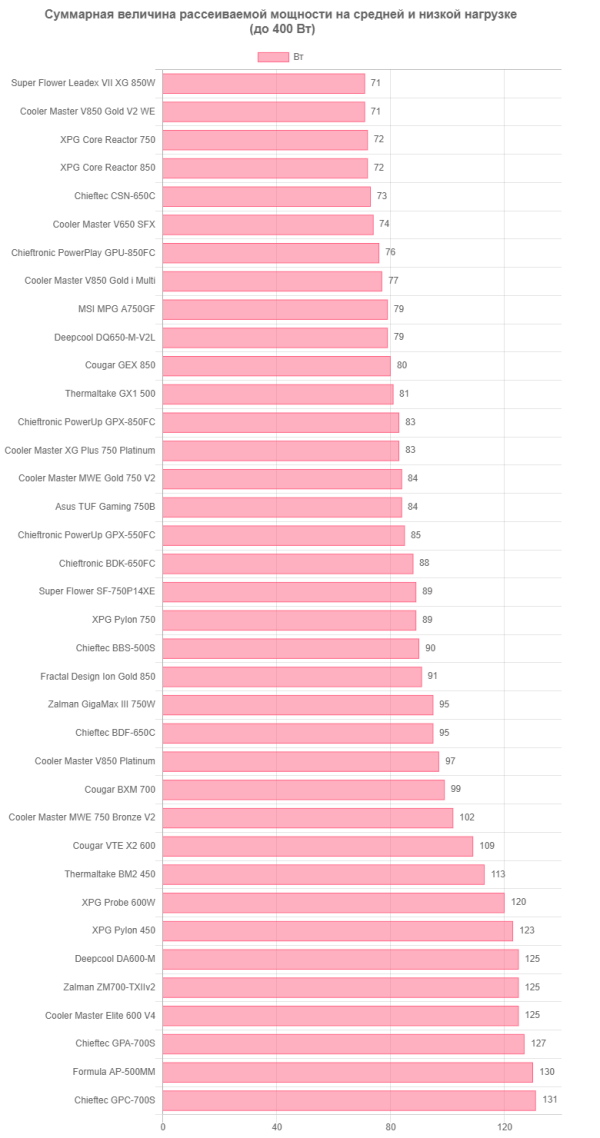
In terms of overall efficiency at low and medium powers, this model occupies a lower position in our rating among tested power supplies up to a kilowatt. However, in absolute value it is located approximately in the middle between the best and worst indicators.
| Computer energy consumption per year, kW h | 15 W | 100 W | 200 W | 400 W | 500 W (1 cord) | 500W (2 cords) | 750 W |
|---|---|---|---|---|---|---|---|
| Cougar BXM 700 | 237 | 1035 | 1980 | 3879 | 4883 | 4880 | |
| Cooler Master Elite 600 V4 | 231 | 1032 | 2016 | 4080 | 5195 | ||
| Cougar GEX 850 | 235 | 1003 | 1933 | 3790 | 4739 | 4735 | 7205 |
| Cooler Master V650 SFX | 200 | 997 | 1924 | 3793 | 4751 | 4743 | |
| Chieftec BDF-650C | 245 | 1042 | 1994 | 3815 | 4991 | 4970 | |
| XPG Core Reactor 750 | 202 | 1001 | 1914 | 3773 | 4746 | 4734 | 7205 |
| Deepcool DQ650-M-V2L | 228 | 997 | 1923 | 3808 | 4765 | ||
| Deepcool DA600-M | 251 | 1049 | 2015 | 4041 | 5133 | ||
| Fractal Design Ion Gold 850 | 262 | 1029 | 1940 | 3830 | 4795 | 4776 | 7273 |
| XPG Pylon 750 | 229 | 1011 | 1942 | 3863 | 4879 | 4877 | 7542 |
| Chieftronic PowerUp GPX-850FC | 244 | 1015 | 1940 | 3795 | 4725 | 4715 | 7177 |
| MSI MPG A750GF | 232 | 1014 | 1936 | 3772 | 4723 | 4713 | 7174 |
| Chieftronic PowerPlay GPU-850FC | 237 | 1015 | 1925 | 3750 | 4678 | 4672 | 7061 |
| Cooler Master MWE Gold 750 V2 | 238 | 1016 | 1936 | 3807 | 4748 | 4744 | 7239 |
| XPG Pylon 450 | 242 | 1038 | 2001 | 4056 | |||
| Chieftronic PowerUp GPX-550FC | 238 | 1011 | 1941 | 3817 | 4793 | ||
| Chieftec BBS-500S | 248 | 1019 | 1947 | 3842 | |||
| Cougar VTE X2 600 | 248 | 1036 | 1997 | 3936 | 4942 | ||
| Thermaltake GX1 500 | 244 | 1000 | 1923 | 3809 | 4797 | ||
| Thermaltake BM2 450 | 238 | 1022 | 1982 | 4011 | |||
| Super Flower SF-750P14XE | 254 | 1021 | 1954 | 3811 | 4748 | 4765 | 7236 |
| XPG Core Reactor 850 | 217 | 1007 | 1911 | 3758 | 4716 | 4704 | 7122 |
| Asus TUF Gaming 750B | 229 | 997 | 1933 | 3842 | 4824 | 4812 | 7385 |
| Chieftronic BDK-650FC | 242 | 1001 | 1931 | 3864 | 4849 | 4823 | |
| Cooler Master XG Plus 750 Platinum | 252 | 1000 | 1918 | 3824 | 4757 | 4730 | 7105 |
| Chieftec GPC-700S | 268 | 1064 | 2023 | 4060 | 5116 | ||
| Zalman ZM700-TXIIv2 | 241 | 1047 | 2022 | 4047 | 5107 | 5081 | |
| Cooler Master V850 Platinum | 287 | 1052 | 1968 | 3806 | 4716 | 4711 | 7083 |
| Chieftec CSN-650C | 225 | 986 | 1905 | 3784 | 4761 | ||
| Powerman PM-300TFX | 237 | 1051 | 2087 | ||||
| Chieftec GPA-700S | 249 | 1045 | 2017 | 4066 | 5138 | ||
| XPG Probe 600W | 244 | 1048 | 2010 | 4012 | 5081 | ||
| Super Flower Leadex VII XG 850W | 234 | 1003 | 1913 | 3738 | 4662 | ||
| Cooler Master V850 Gold i Multi | 226 | 1004 | 1925 | 3784 | 4704 | ||
| Cooler Master V850 Gold V2 WE | 230 | 995 | 1903 | 3758 | 4697 | 4692 | 7118 |
| Cooler Master MWE 750 Bronze V2 | 289 | 1045 | 1955 | 3870 | 4848 | 4855 | 7438 |
| Chieftec EON 600W (ZPU-600S) | 246 | 1049 | 2028 | 4060 | 5160 | ||
| Formula AP-500MM | 239 | 1045 | 2029 | 4087 | |||
| Zalman GigaMax III 750W | 232 | 1013 | 1954 | 3898 | 4900 | 4893 | 7608 |
Temperature
The thermal load of capacitors when operating at power up to maximum is at a low level.
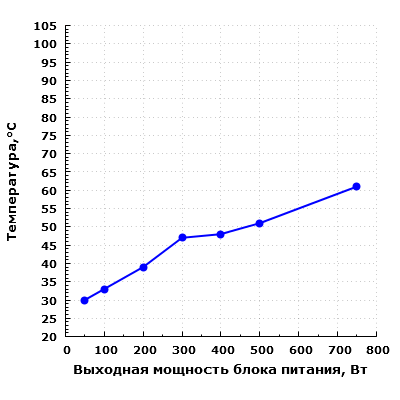
Acoustic ergonomics
The following methodology was used to measure the noise level of power supplies. The power supply was placed on a flat surface with the fan facing upward. At a distance of 0.35 meters above it, the measuring microphone of the sound level meter model Octava 110A-Eco was placed. The measurement was carried out under power supply load conditions using a special stand that ensures silent operation. The process involved running the power supply at constant power for 20 minutes, after which the noise level was measured.
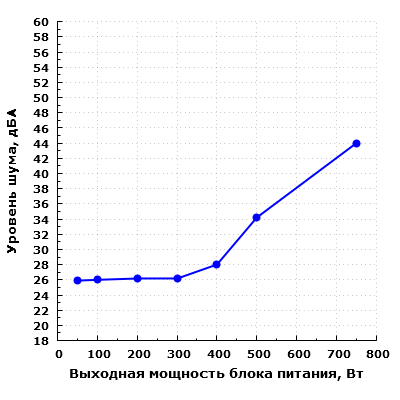
When operating at a power of up to 400 W inclusive, the noise of the power supply remains at a low level for use in residential areas during the day. It's not completely silent, however, and this model doesn't have an automatic fan shutoff feature at low loads, making it less than ideal for those looking for complete silence.
When operating at a power of 500 W, the noise of this model corresponds to the average level for power supplies located in the near field. If the power supply is placed under a desk in a bottom-mounted chassis, the noise may be considered below average. In residential areas this noise level is not very noticeable during the day, especially at a distance of a meter or more, and in offices it is often drowned out by background noise. However, at night it will be noticeable and can disturb your sleep, so this level of noise may be a challenge for the bedroom.
When operating at a power of 750 W, the noise level exceeds 40 dBA, which makes it significantly noticeable in residential areas during the daytime.
Thus, from the point of view of acoustic comfort, this model provides an acceptable noise level at a power of up to 500 W.
Consumer qualities
Zalman Gigamax III 750W (ZM750-GV3) has a high load capacity of the +12VDC channel, which makes it suitable for powerful systems with two video cards or one maximum powerful one.
From an acoustic point of view, this power supply provides comfortable operation with an output power of up to 500 watts, while remaining quiet up to 400 watts. However, at maximum power it produces a high level of noise.
The wires of the unit are long enough for most modern cases; ribbon wires are mainly used, partially removable.
Results
The Zalman Gigamax III 750W power supply (ZM750-GV3) passed all our tests and demonstrated average efficiency without losing its functionality, which deserves a positive rating. In general, this product is a high-quality mid-level solution, although it does not claim to be a leader in its class.
